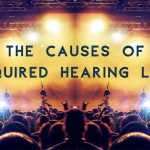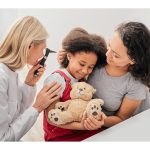As children grow, they learn and adapt to the environments of which they are a part. In their infancy and into toddlerhood, it is up to the parents and caregivers to interpret body language, facial expression, attention, and other nonverbal cues to know what the child may need in a given moment.
Of course, without language it can be that much more difficult to know the source of discomfort or pain they may be experiencing. Tugging at the ears, lack of response to their name or in the direction of sound, unexplained irritability, or wanting the television or radio louder than normal may all be indicators that they should have their ears checked. This kind of keen attention could get your child the hearing help they need early.
Otitis media
The American Speech Language Hearing Association states that otitis media (OM) is an inflammation of the middle ear (the area behind the eardrum) that is usually associated with the buildup of fluid. The fluid may or may not be infected.
The symptoms can vary, along with severity, and length of the condition. An example of a less-severe case might be one short-lived instance of a slight decrease in hearing ability caused by thin, non-infected clear fluid. On the other end of the spectrum, an example of a severe case could be one where the child has repeated infections, thick, glue-like fluid in the ear, possible pain and/or fever, and serious complications such as permanent hearing loss.
Fluctuating conductive hearing loss almost always occurs with any type of OM and is the most common cause of hearing loss in young children.
Prevalence of Otitis Media
OM is the most frequently diagnosed disease in infants and young children and should be considered a dynamic disease, according to a 2003 report by Ingeborg J.M. Dhooge, MD, PhD.
Risk Factors for the Development of Otitis Media continues:
“Otitis media is a disease of infancy. In newborns, acute OM (AOM) is uncommon. By the age of 6 months, approximately 25% of all children will have had one or more episodes of acute suppurative OM. By 3 years of age, up to 81% of children will have experienced at least one episode of OM. After the age of 7 years, the incidence declines.”
It is believed to be prevalent in children due to the still-developing size and position of the eustachian tube, which is smaller and almost horizontal in children. It can, therefore, be blocked more easily by large adenoids or infections until it changes in both size and angle as the child grows.
Otitis Media and Hearing Loss
There are tiny bones in the inner ear which transmit sound vibrations from the eardrum to the inner ear, but when there is fluid in the ear the vibrations are not carried through efficiently. Speech can sound muffled or inaudible as a result of this type of mild to moderate hearing loss.
In general, this type of hearing loss is temporary. But when otitis media occurs repeatedly, there could be damage to the eardrum, the tiny bones of the inner ear, or the auditory nerve itself, causing permanent, sensorineural hearing loss.
Speech and Language Development Inhibition
Since children learn speech and language from listening to those around them talk. This is why it can be quite easy for young children to learn multiple languages. The first few years are very important for development. When a hearing loss is present, the child misses out on essential language-learning.
A particular problem occurs with otitis media without pain or fever. Weeks or longer can pass by before parents realize there is a problem. In the interim, the child could have missed out on formative information in their language development.
Acquired Hearing Loss
Any hearing loss which occurs after birth, at any point in one’s life, is considered acquired hearing loss. It can be the result of a disease, condition, or injury. A few of the conditions that can cause acquired hearing loss are:
- Otitis media
- Ototoxic drugs (damaging to the auditory system)
- Chicken pox
- Influenza
- Head injury
- Noise exposure
If you believe your child is silently exhibiting any of these symptoms, it could be beneficial to speak with hearing health care professionals, three in particular: a physician to administer medical treatment; an audiologist to assess hearing impairment; and a speech-pathologist to assess the child’s speech and language skills.






